Sanskrit and Prakrit Manuscripts
April 18, 2018 in Manuscript Studies, Uncategorized
Palm-Leaf and Paper Manuscripts
[Posted on 18 April 2018, with updates and corrections. Among the updates are new images, showing more specimens in the collection. We thank John Stavrellis, who works toward a Ph.D. in Indology at the University of Bonn, for identifications of the text on some leaves.]
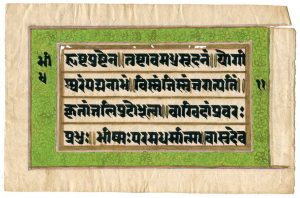 Inspired by some recent communications, as scholars, collectors, and devotees of manuscripts around the world recognize a welcome on our website, we present some fragments from palm-leaf and paper manuscripts which have joined a collection willing to welcome them. This private collection of many varieties of scripts, texts, languages, formats across the ages and across many cultures — see our Galleries — has generously allowed us to display, study, and publish them, along with discoveries that this collaboration permits.
Inspired by some recent communications, as scholars, collectors, and devotees of manuscripts around the world recognize a welcome on our website, we present some fragments from palm-leaf and paper manuscripts which have joined a collection willing to welcome them. This private collection of many varieties of scripts, texts, languages, formats across the ages and across many cultures — see our Galleries — has generously allowed us to display, study, and publish them, along with discoveries that this collaboration permits.
For some time, I have meant to present these images on a Gallery of one kind or another on our nonprofit website. In the transition from our first (Drupal) website to the second (WordPress), I encountered so many difficulties regarding any advance with the Galleries and Media, ensuring an inevitably cumbersome transition from one to the other.
That was then. This is now.
Display
 Without further ado, here are a few of the images that we had intended to present, with generous permission of the owner, who is aware that our wide range of interests about scripts, texts, written sources might gather a broad range of spectators and experts.
Without further ado, here are a few of the images that we had intended to present, with generous permission of the owner, who is aware that our wide range of interests about scripts, texts, written sources might gather a broad range of spectators and experts.
The samples represent Sanskrit and Jain manuscripts of various ages and texts. Their leaves stand on palm-leaf or on paper. Some have illustrations and decorative features.
Their texts comprise single columns of long lines, bordered by vertical bounding lines and/or contained within rectangular frames. Some leaves have centered holes, circular or ovoid in shape, inset within the text, for stringing in a group as a unit. Other leaves have no such holes, but some such leaves include decorative, non-functional ‘stringing holes’. Rendered in red pigment (sometimes with embellishments in ink), their centered circular or similar elements emulate stringing holes, without such functional characteristics. Occasionally, similar red circular elements stand in the margin or both margins, at about mid-column height flanking the ‘stringing hole’.
Context
Some sources of information, among many, offer points of reference and information about the range of materials, languages, and texts.
Jain Manuscripts
Sanskrit Manuscripts
- Sanskrit Manuscripts at the Cambridge University Library
- Sanskrit Manuscripts in the South Asian Rare Books Collection at the Library of Congress, Washington, D.C.
- Sanskrit Manuscripts at the PENN Library of the University of Pennsylvania
- Sanskrit Mauscripts in the Robert Garrett Collections at Princeton University
Palm-Leaf Manuscripts
- An Indic Palm-Leaf Manuscript: Please Help Identify It! (with illustrations, transcription, transliteration, translation, description, and comments)
A Preview
All the images are reproduced by permission of the collector.
Captions and descriptions arise, as our tasks and access to expertise permit.
We welcome your suggestions and information.
As we strive to learn more about these cases and their contexts, we observe that exhibiting such examples might provide pathways to better recognition and understanding of the scripts, texts, materials, layout, and transmission. Our collector observes: “I am of course hardly an expert on these things, as much as I would like to be; one incentive to accumulate them is to attempt to get a feel for their characteristics, as well as to get feedback from those who may know something helpful. Besides that, they are fascinating.”
Samples on Display
I. Hindu Manuscript on Paper, Dated VS 1646 = AD 1589/90
The single column of 7 long lines is bounded by a pair of narrow double bounding lines, which extend the full height of the extant page. The text and bounding lines are monochrome, rendered in black ink.
The date appears in the second-to-last line of text on the page shown here. Among the various luni-solar dating systems employed in the Hindu Calendar, this version represents the Vikram Samvat (= VS), or “Vikram Era”.
Purchased from an online seller.

Hindu Manuscript on Paper, dated VS 1646 / AD 1589/90. Private Collection, reproduced by permission.
[Update: “The date on the first manuscript listed here is given precisely in the colophon. It is Vikrama 1646 | Asadha Suklapaksa 12 which comes to Sunday June 25, AD 1589. This is from a work on grammar called the Śiśubodha.”
—— from Tom Cahill on 18 March 2023 in the Comment below. We express thanks for the information.]
*****
II. Paper Manuscript in Prakrit of the Kalpa Sūtra (Sanskrit: कल्पसूत्र), “The Book of Rituals”, with Decorative Stringing-Holes
The single column of 7 long lines is bounded by a pair of bounding lines, which extend the full height of the extant page. The bounding lines take the form of a band edged with ink contours and filled with red pigment. Offset towards the left, the ‘stringing hole’ comprises a circle filled with red pigment.
Presenting the biographies of the Jain Tirthankaras, this text is traditionally held to have been composed by Bhadrabahu I. The oldest surviving copies of the Kalpa Sūtra, written on paper, were made in Western India in the 14th century. From the mid 15th-century onward, copies often — as here — have illustrations of scenes.
Western India, Gujarat or vicinity.
Circa 1500 CE.
Purchased in the Portobello Road Market, London.
Folio 28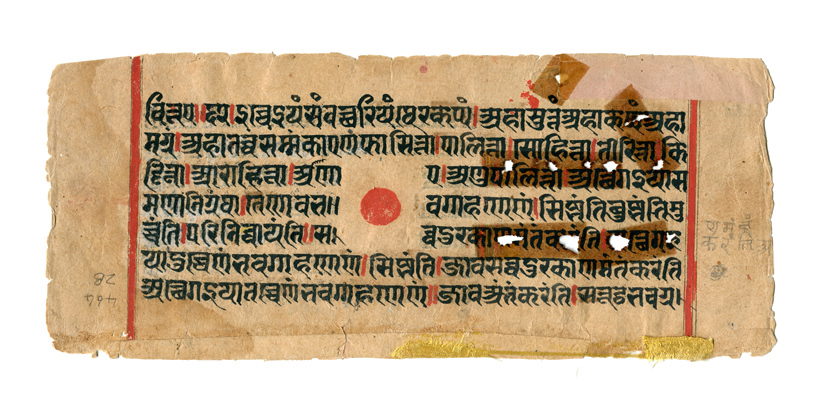 Folio 36 with illustration
Folio 36 with illustration
On this side of the leaf, the red ‘stringing hole’ is accompanied by a matching pair of red-filled circles which stand in the margins. Standing to the right-hand-side within the column of text, and set within a band-like rectangular border filled with red pigment, the illustration comprises 3 tiers. Each contains 2 or 3 part- or full-length stylized human figures with faces turned in profile or three-quarter view.

Detail of Illustration
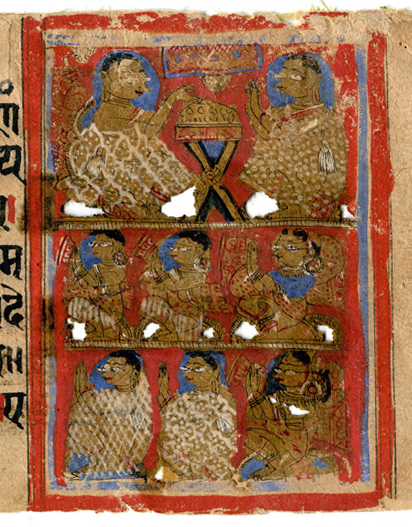
*****
III. Manuscript on Paper with Decorative ‘Stringing Hole’
Leaf on Paper. The single column of 14 long lines is bounded by a pair of red-filled band-like bounding lines, which extend the full height of the extant page. More-or-less centered within the column, the ‘stringing hole’ comprises a more-or-less circular element filled with red pigment.
Western India.
Circa 1500 CE.
Purchased from an online seller.
Both sides of the leaf:
*****
IV. Palm-Leaf Manuscript in Sanskrit from Nepal from the Bhagavadgita, 2:21–29, with Functional Stringing Hole
The single column of 5 long lines contains a broad ovoid stringing hole, offset towards the left.
The text presents a portion of the Bhagavadgita, Chapter 2, Verses 21–29.
Probably 15th Century CE.
Purchased online from a seller in the U.S.A.
[Update: We thank John Stavrellis, who works toward a Ph.D. in Indology at the University of Bonn, for identifying the text on this page.]
And There’s More
And now, inspired by the identification by John Stavrellis, another image from the same manuscript:

*****
V. Astrological Manuscript in Sanskrit on Paper, with Functional Stringing-Hole
The single column of 9 long lines is bounded by a pair of band-like bounding lines, which extend the full height of the extant page. The irregular ovoid stringing hole is offset to one side within the column. Annotations in the form of commentary or diagram appear within some margins.
The manuscript is incomplete, lacking a colophon. Its text appears to be astrological.
Purchased online in 2 groups of leaves, which amount to a substantial part of the manuscript, albeit incomplete.
The manuscript is old enough to have functional stringing holes, rather than solely decorative ones.
The style of writing appears to be Jain. A quick guide to the sort of script is offered by Omniglot: Devanagiri (देवनागरी लिपि). Examples digitized by the Cambridge University Library appear here.
Probably 15th century CE.
Purchased from an online seller.
Detail of the Title
First Page of Text
Page of Text with Diagrams
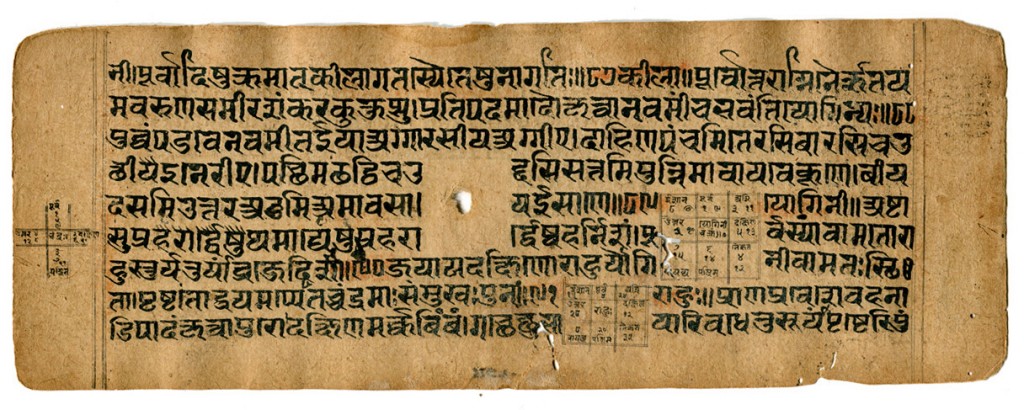
*****
VI. Paper Manuscript in Sanskrit with the Devī Māhātmyam, Verses 81:58–61 and 83:13–18
The single column variously of 7 or 6 long lines is bounded on only the left-hand side by an outlined band-like set of bounding lines, which extend the full height of the extant page.
The pages shown here, in a single image, are out of order textually. Both have portions of the Devi Mahatmya or Devi Mahatmyam (Sanskrit: devīmāhātmyam, देवीमाहात्म्यम्), or “Glory of the Goddess“), a Hindu religious text describing the Goddess as the supreme power and creator of the universe. This text, believed to have been composed in in Sanskrit between 400–600 CE, comprises chapters 81–93 of the Mārkandeya Purana, one of the early Sanskrit Puranas, taking the form of a set of stories related by the sage Markandeya to Jaimini and his students — who appear in the form of birds.
Here the upper page shows parts of Verses 83:13–18, while the lower page shows Verses 81:58–61.
Mahatmyas are frequent features of Puranic texts. They are later compositions which were added to the original Puranas, so as to impart to the Mahatmya greater religious authenticity and validity. Mahatmya texts are eulogistic, composed to extol the holiness of particular divinities and/or localities as figures/places worthy of pilgrimage. These texts also describe the great benefits conferred upon the devotees who follow the mahatmya’s instructions for pilgrimage and worship.
Purchased from an online seller.
[Update: We thank John Stavrellis for identifying the text on this page.]
*****
VII. Fragmentary Manuscript on Paper with the Vishnu Sahasranama stotra, Verses 57–66
The single column of 5 long lines is bounded by a pair of band-like bounding lines, irregularly filled with red pigment, which extend the full height of the extant page. Where the lines of text do not remain within the preset confines of the bounding lines, but extend within or beyond them, the red pigment infill obliges by adopting an undulating course around their span.
The text belongs to the Vishnusahasranamastotra, or Vishnu Sahasranāma stotra, a text or hymn (stotra) listing and describing the many attributes and epithets (sahasranāma) of the god Vishnu. These pages show verses 57–66.
Perhaps 18th Century CE.
Purchased from an online seller.
[Update: We thank John Stavrellis for identifying the text on this page.]
*****
VIII. Leaf from a Paper Manuscript in Sanskrit, from the Bhīṣma-stava-rāja, Chapter 47, with Ornate Borders
The 4-line column of text in long lines stands within an elaborately ornamented frame.
On each side of the leaf (which survives in fragile condition), the gold-framed rectangular frame enclosing the column of text encloses a continuous border. The border presents an intricate, frieze-like series of compacted floral designs painted upon a colored ground. The designs are rendered respectively in gold pigment upon bright blue background (on the recto) or dark green pigment upon bright green background (on the verso). The grid- or ladder-like frame enclosing the column of text introduces horizontal bands (or rungs) within which each line of text hovers or (for the last line) stands.
The text comes from the Bhīṣma-stava-rāja (भीष्मस्तवराज), chapter 47, of the Śānti Parva, twelfth and longest among eighteen books in the long epic poem Mahābhārata. It represents a hymn of praise of Kṛṣṇa by Bhīṣma. The text here corresponds to verses 6-9 of the recension transliterated by Muneo Tokunaga: here .
Online facsimiles of witnesses to the text include University of Pennsylvania, MS Coll. 360 .
Purchased from an online seller.
Recto
Verso
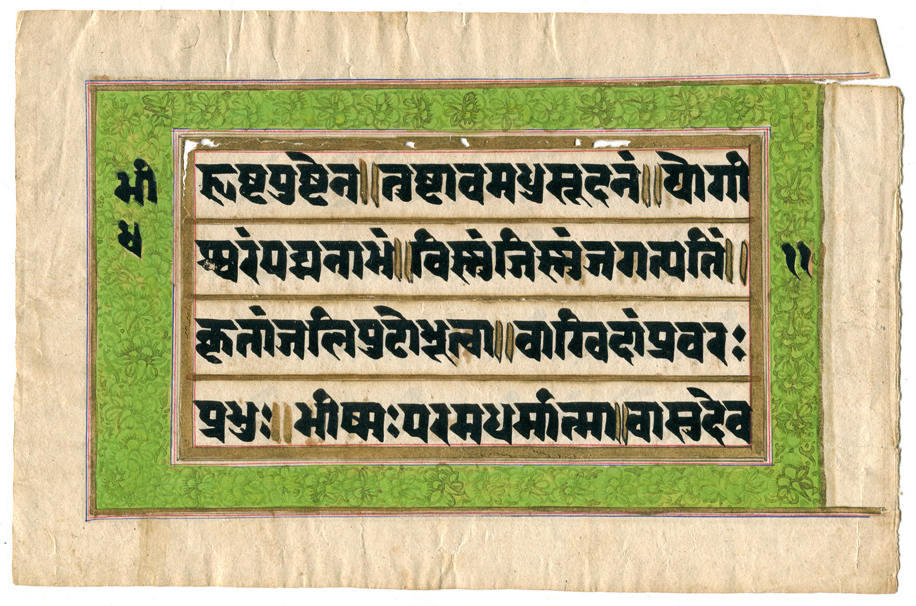
Detail of Verso

[Update: We thank John Stavrellis for identifying the text on these pages.]
*****
NEW (as of March 2019)
IX. Fragmentary Manuscript on Paper with Spacing for an Omitted Decorative Stringing Hole
The single column of 9 long lines is bounded by a pair of triple vertical bounding lines, rendered in red pigment, which extend the full height of the extant page. The lines of text subdivide in the center of the column in geometric stepped formation, making space for a decorative stringing hole, albeit omitted.
Purchased from an online seller.
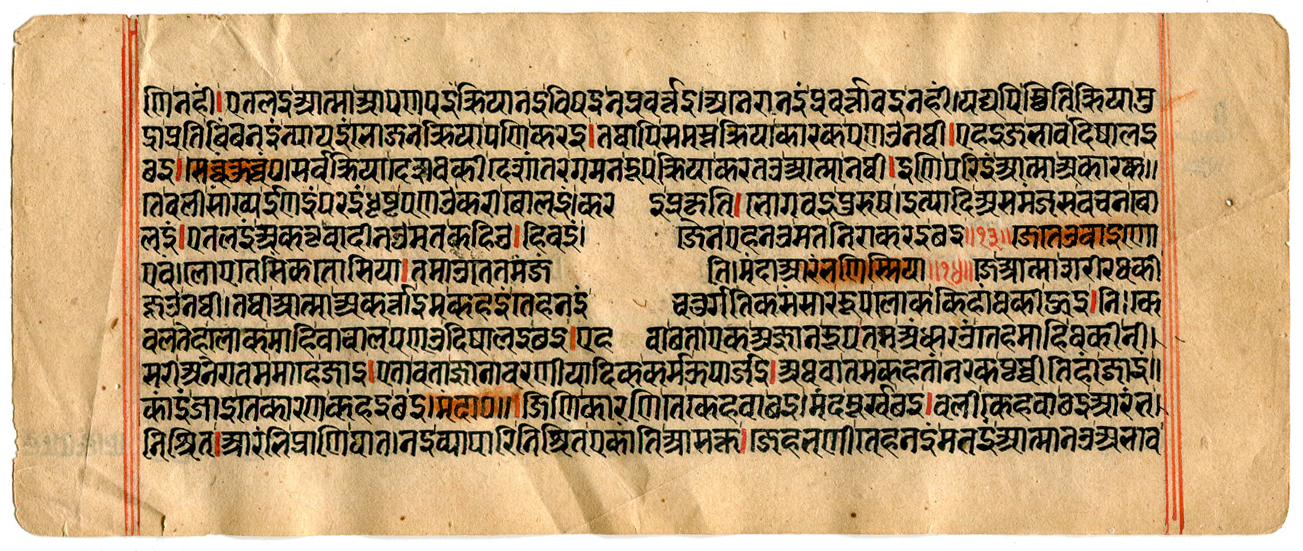
X. 3 Leaves from a Manuscript on Paper with a Functional Stringing Hole and both Interlinear and Marginal Entries
The single column variously of 7 or 6 long lines is bounded by a discreet pair of triple bounding lines, which extend the full height of the extant page. The circular stringing hole (torn on one leaf with an extended ‘tail’ which rises diagonally) is surrounded by a more-or-less circular frame of red pigment. There are multiple densely-compacted and neatly written annotations both in between the lines of text and in all the margins.
Purchased from an online seller.
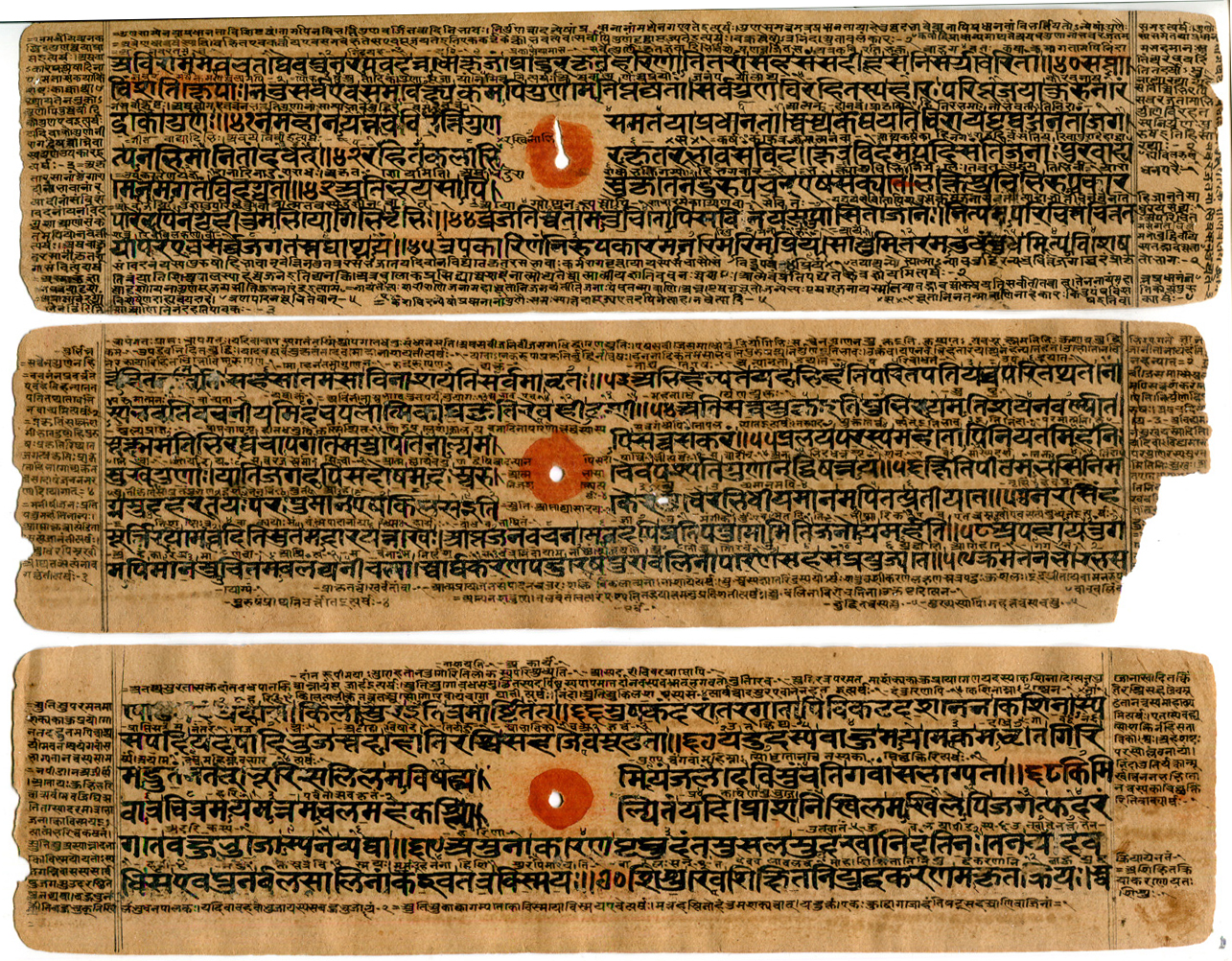
*****
XI. Fragment of a Manuscript Leaf on Paper with a Rectangular Frame, a Functional Stringing Hole, and Marginal Commentaries
Damaged at both sides, the leaf has a single column of 3 long lines of ‘text’ comprising diagrams with dotted patterns or script. These lines stand within a rectangular band-like border, edged with ink and filled with red pigment. The border has vertical extensions at the side (only one side survives), which extend the full height of the extant page. The stringing hole comprises a circle with an extended tear. Geometric ink designs embellish the red circle surrounding the stringing hole.
Purchased from an online seller.
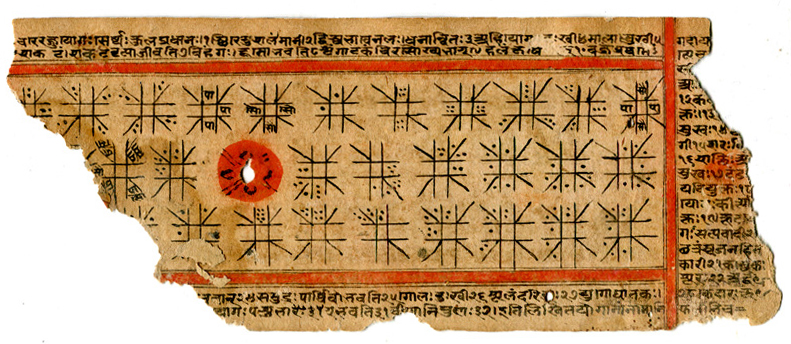
XII. Manuscript Leaf on Paper
with a Bordered Rectangular Frame and Polychrome Lines of Text
The column of 6 long lines of text stands within a bordered rectangular frame comprising a nested series of bands. The broadest band is filled with a pale reddish or orange pigment. The lines of text alternate in color regularly between red pigment, black ink, and gold leaf laid within ink outlines.
Purchased from an online seller.

XIII. Fragment of a Manuscript Leaf on Paper
with a Bordered Rectangular Frame and a Decorative Background
The column of text in 6 long lines stands within a bordered rectangular frame comprising a nested series of bands. The broadest band is filled with yellow pigment. Around the frame and partly extending into it, an irregular speckled pattern serves as a decorative background for the margins.
Purchased from an online seller.

*****
NEW (as of June 2020)
XIX. Fragmentary Manuscript on Paper with Spacing for an Omitted Decorative Stringing Hole
One of 2 leaves from a Hindu or Jain manuscript, 16th century CE. The single column of 15 long lines is bounded by a pair of vertical bounding lines, which extend the full height of the extant page. The lines of text subdivide in the center of the column in geometric stepped formation, making space for a decorative stringing hole, albeit omitted.
Purchased from an online seller.
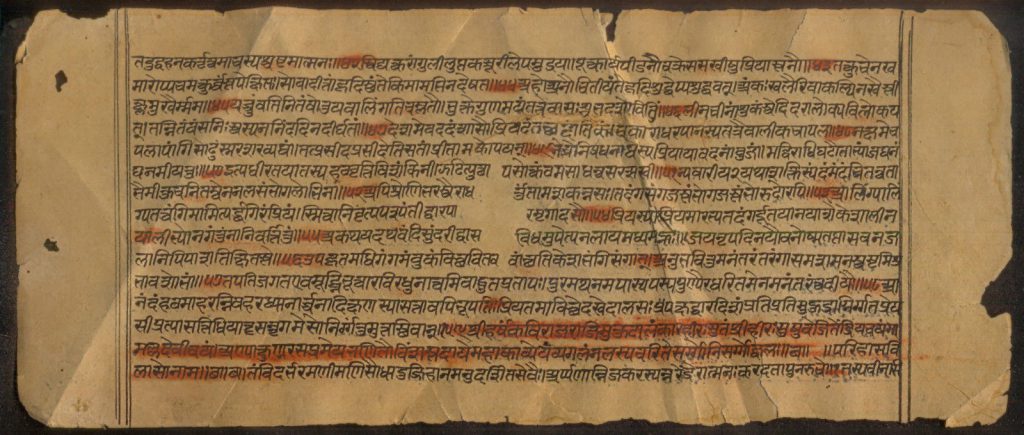
One of 2 leaves from a Hindu or Jain manuscript, 16th century CE.
*****
New (as of March 2021)
XX. Bengali Manuscript on Paper with Spacing for an Omitted Decorative Stringing Hole

Private Collection, Bengali Paper Manuscript, Opened.
The single column of 5 long lines includes a subrectangular space left blank at the center for a decorative stringing hole.
The presence of that decorative, unused ‘hole’ perhaps indicates an early date.
Purchased from an online seller.
*****
Do you have suggestions, corrections, and refinements concerning these pages? We hope to learn more.
Please add your Contacts below and/or Contact Us. Also, please visit our Facebook Page.

*****
Update:
Now see also
- David W. Sorenson, A Quick Introduction to Indian Manuscripts for the Non-Specialist, available as a pdf.
- David W. Sorenson, Paper-Mounds and Paper Traditions: What Mould-Patterns in Near-Eastern and Indian Paper Suggest Regarding Origins of Local Papermaking, available as a pdf.
*****




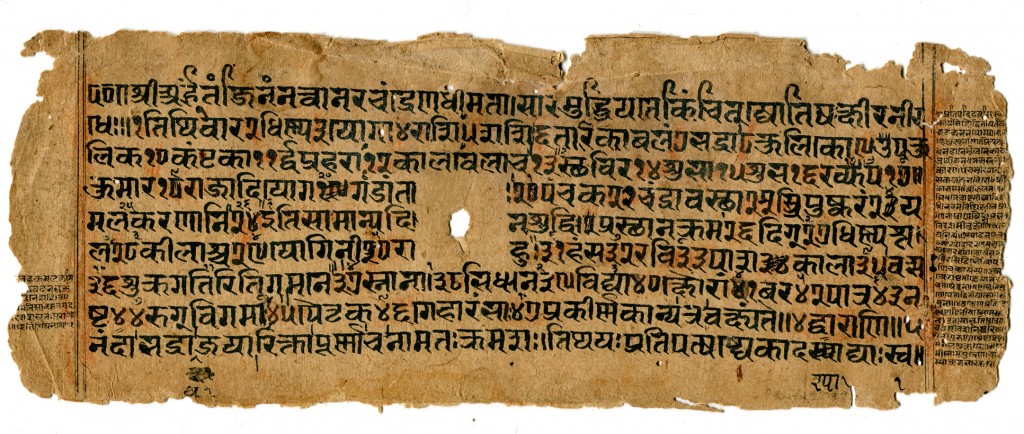
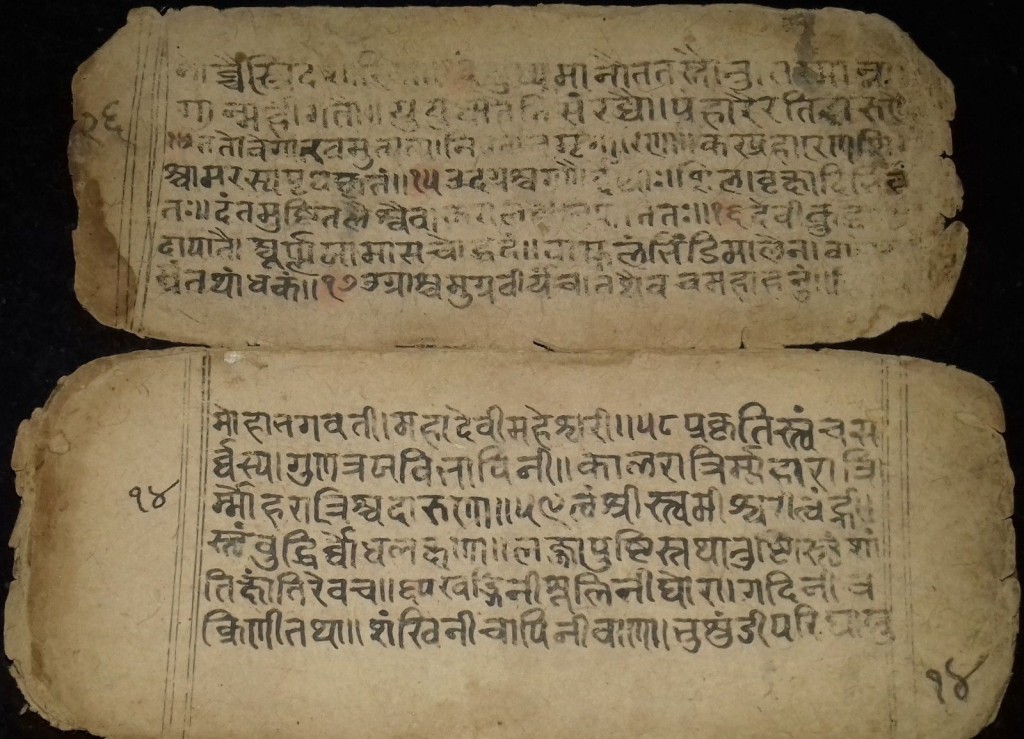

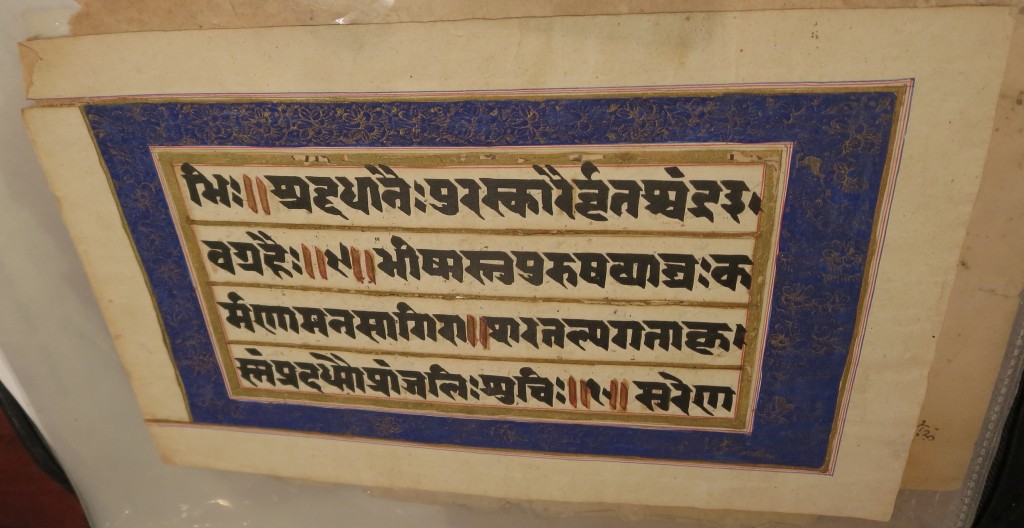
It was really insightful.
Thanks for such a nice content.
Cheers
BTW if anyone interested more have a look . thanks
The date on the first manuscript listed here is given precisely in the colophon. It is Vikrama 1646 | Asadha Suklapaksa 12 which comes to Sunday June 25, AD 1589. This is from a work on grammar called the Śiśubodha.
Thank you very much for your information! We will report it in the post as an update. With best wishes!
Thank you for sharing this. I have a lot of pieces of these materials in my library and they are not described yet. If someone wants to collaborate with me and publish about these materials, please email me. If the email is not found in this website, I have a good digital footprint where I can be reached.